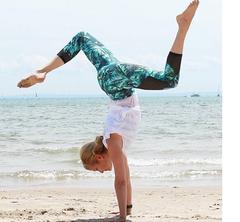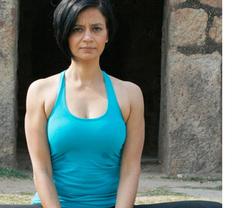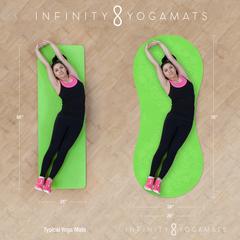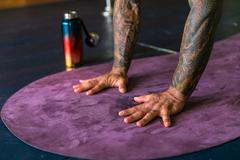Ask The Experts: What These 6 Top Yoga Teachers Look For In A Good Yoga Mat

You love yoga! Maybe you’ve just recently discovered yoga and how amazing it makes you feel. Or, maybe you’ve been practicing for years, and you tell everyone you know about your favorite yoga classes nearby.
Wherever you are on the yoga spectrum, you need a yoga mat.
There used to only really be one kind of yoga mat -- a rectangular rubber mat, actually made of PVC.
You’ve probably owned one of these mats at some point in your life if you’ve practiced any kind of yoga or Pilates.
But now there are many different kinds of mats, with a lot of different features and benefits. How do you choose which mat is for you?
We asked six top yoga instructors what qualities or features they look for in a good yoga mat.
Here’s what they had to say:
Kia Miller, Radiant Body Yoga
 Kia Miller was named one of the 10 inspiring yoga teachers you should know on DoYouYoga.
Kia Miller was named one of the 10 inspiring yoga teachers you should know on DoYouYoga.
She taught at Yogaworks in LA for 15 years, but now offers immersive trainings and retreats through her business Radiant Body Yoga.
You can also take Kia’s classes online through YogaGlo.
When asked what she looks for in a good yoga mat, Kia listed a few qualities:
- Not made of rubber, as the smell lingers and gets onto my body and clothes.
- Not slippery.
- Lightweight enough to travel with.
- Durable, so it lasts a lifetime.
Noah Mazé, YOGAMAZÉ
 Noah Mazé was also listed on the DoYouYoga list of 10 inspiring yoga teachers.
Noah Mazé was also listed on the DoYouYoga list of 10 inspiring yoga teachers.
That article says that he is “today considered one of the USA’s most knowledgeable yoga teachers.”
Noah and his wife founded their YOGAMAZÉ yoga teacher training school in 2012, and he also teaches workshops and classes around the world.
According to Noah, the “yoga teacher’s teacher” there are four things that are most important when he’s looking for a yoga mat
- Portability - While I have a few thicker mats at home, I never travel with or transport those mats off site. They are what I call my “base camp” mats. Most of the time I use a travel mat for taking or teaching classes in my local area, to which I usually ride my bike, and also to bring with me on trips. It folds or rolls up and fits easily in my bag along with my other yoga stuff. Further, I prefer the direct feedback that a thin mat gives, and it’s easy enough to fold my mat towel to pad my knee for certain poses. Lastly, thinner mats are easier to wash and quicker to dry.
- STICKY mat - I want the mat to hold me firmly, even when I sweat. Different people prefer different brands and types of mats for this purpose, and I think there is not a “one mat sticks for all” notion, but through trial and error I have definitely found which mats give me better traction. Some mats need a break-in time, and you might be able to speed this up by bringing the mat into the shower with you and scrubbing it down a bit.
- No Stretch - I don’t want my mat to stretch when I’m in a pose. Too often, particularly with thinner mats and eco materials, my downward-facing dog pose gets a few inches longer when I test the mat. Additionally, I want it to lay flat on the floor and not easily bunch up.
- Eco Conscious - I am happy to see more and more eco conscious and biodegradable mats on the market. It is important that we, as yogis, lead by example and make sustainable and ethical choices. Also, I prefer to touch natural and organic materials and definitely feel the difference. Sometimes natural rubber has a strong smell in the beginning, so you may need to leave your mat unrolled for a few days in a ventilated area.
Noah also gave this advice when you’re choosing your next yoga mat:
“When possible, test the products that you are considering and see how the mat feels and suits your needs, and perhaps, like me, you have a home practice mat as well as a portable mat to best serve your practice.”
Heidi Kristoffer, heidiyoga.com
 Also one of the 10 inspiring yoga teachers you should know, DoYouYoga says Heidi Kristoffer is “known as the ‘upside-down girl’ due to her penchant for inversions.”
Also one of the 10 inspiring yoga teachers you should know, DoYouYoga says Heidi Kristoffer is “known as the ‘upside-down girl’ due to her penchant for inversions.”
Heidi teaches in New York City and created CrossFlowX: “a fast-paced blending of strength, core, inversion and arm-balance-focused flows, high intensity cardio intervals, traditional yoga kriyas, and a little bit Xtra, this class is one big sweaty yoga party!”
When asked what qualities she looks for in a yoga mat, she said:
- Non-toxic, sustainable ingredients.
- Stays put on the ground (doesn’t move or come up in regular yoga moves like vinyasas).
- Non-slippery surface.
- Easy to roll up.
- Not too heavy to carry.
- Will last and not fall apart for a long time.
Cristina M. Kuhn, Yoga Medicine

Cristina M. Kuhn, E-RYT 500, KYT 500, IPT, Yoga Medicine® instructor, currently teaches at The Yogi Underground in Falls Church, Virginia.
When we asked her what she likes to see in a yoga mat, she said:
I am often asked, what do you look for in a yoga mat? As a yoga practitioner, teacher, and studio owner, I have tried many different mats, but the ones I love the most possess the following qualities:
- Cushion and support. My bones need some give in a yoga mat, but not so much that it affects my ability to balance.
- Ease of care. Some yoga mats are hard to clean thoroughly and therefore retain odor; I cannot bear a smelly mat, so it needs to actually be clean when I clean it.
- Kindness for the Earth. Any mat I use needs to be eco-friendly with no off-gassing (again, no smelly mats).
- Stability and comfort. I like a mat that allows me to move with ease, but also supports stability when I am in stillness.
- Relatively lightweight. I do not want the act of carrying my mat across town to deplete me. My energy is valuable and I practice yoga to fill my vessel, not empty it.
Seema Sondhi, The Yoga Studio
 Seema Sondhi’s The Yoga Studio in New Delhi, India, was named one of the top 25 yoga studios around the world by Travel + Leisure.
Seema Sondhi’s The Yoga Studio in New Delhi, India, was named one of the top 25 yoga studios around the world by Travel + Leisure.
She opened the studio in 2001, and she seeks to “help individuals on a healthier and more peaceful path by teaching them a system of exercise that fully integrates the body, mind and soul.”
When asked what she looks for in a yoga mat, Seema said:
- It should be affordable.
- In natural fibre, as we need to save the planet.
- The mat should be lightweight so that we can carry it everywhere we go, hence there is no excuse for us to practice.
- The mat should be non slippery for all our advanced poses.
- It should be sweat absorbent.
Shayna Hiller, shaynahiller.com
 Shayna Hiller is a yoga teacher and certified health coach based in Venice Beach, California.
Shayna Hiller is a yoga teacher and certified health coach based in Venice Beach, California.
She’s been teaching yoga for 15 years and is currently teaching at The Yoga Collective in person and through online classes, in addition to retreats and workshops around the world.
Shayna said she looks for a few qualities in a good yoga mat:
- First of all, it has to have a wonderful grip. I do not like using the mat towel on top of my mat, so I want to make sure that I don’t need anything extra and that the mat itself is non-slip and durable.
- I also make sure that mats are non-toxic and do not have an artificial odor.
- It is also important for mats to have the proper thickness. Many companies offer various thicknesses and that is important to protect joints.
Key Yoga Mat Features
So, what are the key features and qualities that experienced yoga teachers are looking for in a yoga mat?
Here are the eight features these six experts said they look for, as well as how the Infinity Yoga Mat stacks up to these features:
1: Made of eco-friendly, non-toxic materials
 You’re putting your body on this mat and breathing it in. You don’t want to worry about if your yoga mat is leaching chemicals into your body while you’re trying to exercise, meditate, and be healthy.
You’re putting your body on this mat and breathing it in. You don’t want to worry about if your yoga mat is leaching chemicals into your body while you’re trying to exercise, meditate, and be healthy.
Many mats are made of polyvinyl chloride (PVC), widely considered one of the most toxic plastics and a known carcinogen, so you want to watch out for that.
Natural rubber, which may have a slight smell when it’s new, is much more eco-friendly and non-toxic.
Infinity: The Infinity Yoga Mat is made of all-natural tree rubber and microfiber suede. It is eco-friendly, biodegradable, and made of 100% recyclable materials. They contain no PVC, are BPA-free, non-toxic, and meet the highest of manufacturing standards.
2: Good grip, not slippery
 Staying in place in your pose, and not slipping, even when you’re sweaty, is a big deal.
Staying in place in your pose, and not slipping, even when you’re sweaty, is a big deal.
Losing your grip means losing your focus.
You want to be able to stay still and keep your hands and feet in place on your mat, no matter what kind of yoga you’re doing.
Keeping that grip when your mat, hands, and feet are wet and sweaty can be hard with many mats, especially if you don’t also have a mat towel on top.
But, like Shayna Hiller said, those mat towels can get in the way and make your mat not as grippy too.
Infinity: Good grip is one of the key features of the Infinity Yoga Mat, whether you are using it for hot yoga or a cooler, flow yoga class.
The microfiber suede side absorbs moisture and grips better the wetter it gets, so you can use that side for your hot yoga, or even just if your hands and feet get a little sweaty while you’re practicing.
Put the black side of the mat face up when you’re doing low-intensity yoga sessions for extra grip when you’re not sweating.
3: Lightweight/portable
 Having a mat that you can carry around town, or travel with may be important to you too, depending on how far you go to practice yoga.
Having a mat that you can carry around town, or travel with may be important to you too, depending on how far you go to practice yoga.
If you’re practicing at home, or driving to a studio, the weight of your mat may not be as big of a deal, especially if it’s still easy to carry around.
You also have to consider how the weight of the mat impacts the other features you’re looking for, like durability, the quality of the materials, thickness, and size.
Infinity: The Infinity Yoga Mat is bigger in size than a standard yoga mat. A standard yoga mat is 68 inches long x 24 inches wide. But, the Infinity Yoga Mat is 78 inches long x 26 inches wide at its narrowest point, 34 inches wide at the widest.
The slightly bigger size gives you the freedom to move around while you’re practicing without worrying about staying on your mat.
The extra size, plus the density of all-natural tree rubber makes the Infinity Yoga Mat a little heavier than your standard yoga mat. It weighs about 7 pounds.
But, it also comes with a carrying strap included, which makes it easier to carry around with you on your shoulder.
4: Durable
Having a mat that doesn’t fall apart, and lasts a long time is important, especially if you’re investing some money into that mat.
You don’t want to have to replace your mat all the time, but rather have a mat that you know you can use regularly and is going to last.
Infinity: The Infinity Yoga Mat is a quality mat made out of high quality materials that should last a long time.
And, because the mat is also machine washable, you know you’ll be able to clean it regularly and keep it looking and smelling nice for a long time.
5: No Stretch/Stays In Place
 A mat that not only has grip for your hands and feet (on top of the mat), but also grips to the floor is a nice feature to have.
A mat that not only has grip for your hands and feet (on top of the mat), but also grips to the floor is a nice feature to have.
The floor you’re practicing on may be slippery, so your mat needs to have some grip on the bottom to make sure it’s not slipping all over the floor or stretching out while you’re doing your downward-facing dog.
Infinity: The black, all-natural tree rubber side of the mat has a lot of grip and sticks firmly in place on any floor it’s on. It doesn’t stretch out while you’re doing down-dog and it doesn’t slip around the floor.
Also, because of the weight of the mat, it rolls out nicely and doesn’t wrinkle or bunch up.
6: Cushion/joint protection
 Yoga mats come in all different thicknesses, and depending on how much cushion and joint protection you think you need for your body will determine how thick you think your mat should be.
Yoga mats come in all different thicknesses, and depending on how much cushion and joint protection you think you need for your body will determine how thick you think your mat should be.
Typical yoga mats are about ¼ inch, or 3 mm, thick but there are both thinner and thicker mats.
Thickness also comes with weight, so that is something to consider when you’re thinking about how thick you want your mat to be.
In addition, thicker mats may also be less stable, especially for standing poses when you want a strong connection to the floor.
Infinity: The Infinity Yoga Mat is 3 mm thick, the same thickness of a standard mat. It provides plenty of cushion for a regular yoga practice.
For more intense poses on the floor, or for a Yin practice, you may need a blanket or towel under your knees or other joints.
7: Easy to clean
Although not mentioned much by the yoga teachers here, being able to clean your yoga mat is important, especially after one of those especially hot and sweaty classes!
Infinity: The Infinity Yoga Mat is very easy to clean -- it’s machine washable! The microfiber suede absorbs your sweat, so it’s nice to be able to wash it out too.
Throw it in the washing machine and hang it to dry. It may take about one full day to completely dry out.
You can also hand wash the Infinity Yoga Mat with warm soapy water and allow it dry.
8: Affordable
Yoga mats come at many different price points, and of course, you get what you pay for most of the time.
You should consider the price among all the other features that are most important to you when looking at yoga mats.
Infinity: The Infinity Yoga Mat costs $88 and comes in four amazing patterns. You can get free shipping with promo code EXPERTS.
Learn More About Infinity Yoga Mats

If you’re looking for a new yoga mat that meets many of these qualifications listed by our expert yoga instructors, take a look at the Infinity Yoga Mat. You can get free shipping with the discount code EXPERTS.
It’s the world’s first and only yoga mat designed to fit the shape of your body and the movements of your practice.
Blog post written by Jessica Berlin, freelance writer and content marketer at jessicaberlin.com.

